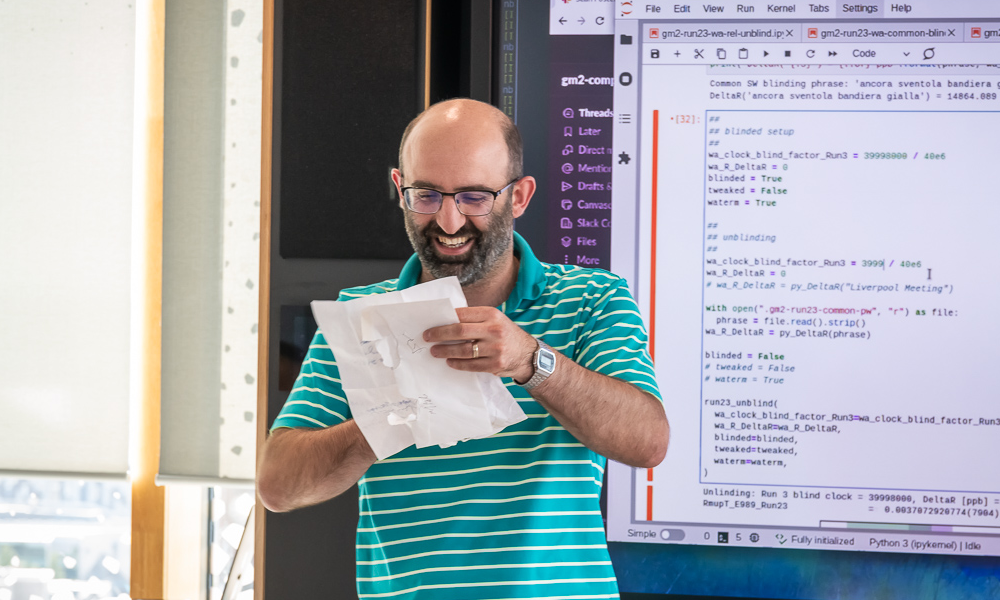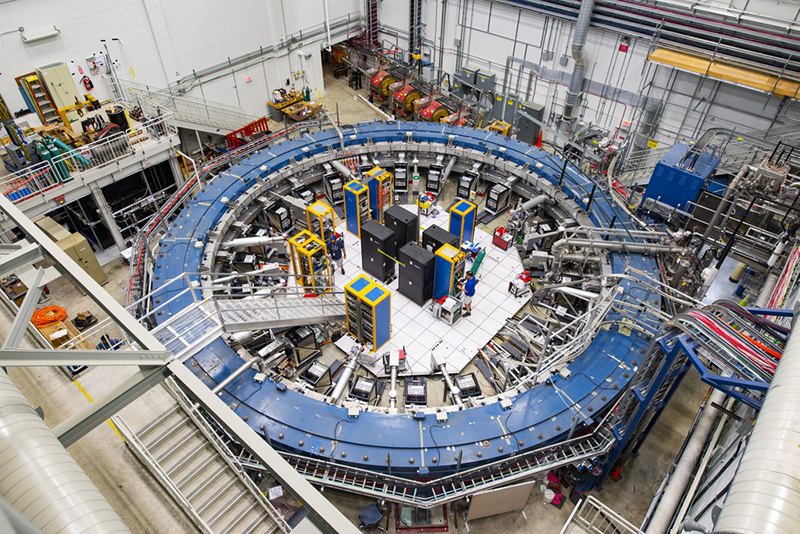Mismatch with Standard-Model Predictions Reaches 5 Sigma
Tension was in the air on July 24 as members of the Muon g-2 Collaboration gathered in a conference room at the University of Liverpool, UK. The scientists had congregated to “unblind” their latest measurements of an anomalous property of the muon, an unstable particle that makes up much of the cosmic radiation that reaches Earth’s surface. When input into the computer, would the figures in two sealed envelopes reveal a match between the new analysis and a previous one? Or would the team have to announce that something had gone awry? There was a fear that values would be inconsistent with the collaboration’s earlier findings, says René Reimann, a physicist from the Johannes Gutenberg University Mainz, Germany, who was in the room that day.
Blinding results is “the right scientific thing to do, but it is so nerve wracking,” says James Mott of Fermi National Accelerator Laboratory (Fermilab), Illinois, who read out the numbers that day. “There is only one way it goes right…and many ways it can go wrong.” Those nerves quickly dispelled as Mott read out the numbers. Not only were the values consistent with the older ones, but they were also twice as precise. Mott and Reimann felt relief wash over them. “Everybody was happy,” Reimann says. “Everything fit together.”
The numbers shared two weeks ago in Liverpool—and today with the world—are the latest update in a decades-long effort to tease out the exact values of the muon’s magnetic moment and its “g-factor” (see Special Feature: The Muon g-2 Anomaly Explained). The magnetic moment of a particle—a measure of the torque exerted on it by a magnetic field—is proportional to the particle’s charge and spin via a dimensionless parameter called the g-factor.
In a hypothetical world where the muon behaves as an isolated, idealized point particle, its g-factor will equal 2. In the real world, where the muon constantly interacts with other “virtual” particles flashing in and out of existence, its g-factor is slightly larger than 2. The difference between real and hypothetical values—the so-called g − 2 anomaly—arises because the virtual particles modify the effective charge of the muon and the speed at which its spin rotates in a magnetic field. The Muon g-2 experiments measure this speed and use it to determine the muon’s magnetic moment and the g − 2 anomaly.
Calculations based on the standard model of particle physics currently predict that the muon has a g-factor of 2.00233183620(86). (The numbers in parentheses represent the uncertainties in the predictions.) Experiments have long turned up a slightly different number. But it wasn’t until two years ago that researchers had compelling evidence that the discrepancy was real and not a measurement artifact (see Viewpoint: Muon’s Escalating Challenge to the Standard Model). That evidence came from experiments by the Muon g-2 Collaboration, which were performed at Fermilab (see Research News: Measuring the Magnet that Measures the Muon).
In 2021, the collaboration reported that their measurements—combined with earlier ones—gave the muon a g-factor of 2.00233184122(82), a value that disagrees with predictions. At the time, the experiment–theory discrepancy had a statistical significance of 4.2 sigma, meaning that chance that it wasn’t real was 1 in 40,000. The experimental value announced today of 2.00233184110(48) is twice as precise as the 2021 figure and the statistical significance of the discrepancy has jumped to 5 sigma or, if the earlier results are averaged together with the new ones, 5.2 sigma. “[Our result] is very exciting…and a big achievement,” says Anna Driutti, a Muon g-2 Collaboration member who works at the University of Pisa in Italy. We have the “most precise experimental measurement of the muon g − 2 to date, that’s for sure.”
A significance level of 5 sigma or more is typically enough for scientists to claim a discovery. But the Muon g-2 Collaboration is cautious on that front. While the experimental values now seem established—although their precision is expected to increase once the team finishes its analysis of another three years of collected data—the theoretical values are not yet set in stone. In 2021 “lattice-QCD” predictions determined parameters that sit slightly closer to the experimental ones than those obtained with other methods. Theorists are still working on understanding this discrepancy. “With the new uncertainty now standing at 0.20 [parts per million], we’re really laying a marker down to spur on the theory community to solidify the prediction,” Mott says.
“A precise measurement of a fundamental constant is an enduring result that will continue to yield dividends into the future,” says Priscilla Cushman, a physicist at the University of Minnesota who worked on an earlier g-2 experiment. “While we may have to wait until the theory gets sorted out to have confidence in the size of the standard-model discrepancy, the g − 2 measurement campaign at Fermilab has yielded the gold standard by which all newly proposed particles and interactions must be judged.” She notes that whether scientists are proposing new dark matter candidates or trying to understand anomalous results from ultrahigh-energy particle collisions, such as those performed at the Large Hadron Collider, the models they use must be consistent with the limits imposed by g − 2.
For the Muon g-2 team, those considerations are for another day. Today, it’s time for them to celebrate. “All the years of taking more data and the huge efforts of mostly early-career researchers in beating down the uncertainties [have] really paid off,” Mott says. “[We should] be very proud of the achievement.”
–Katherine Wright
Katherine Wright is the Deputy Editor of Physics Magazine.







